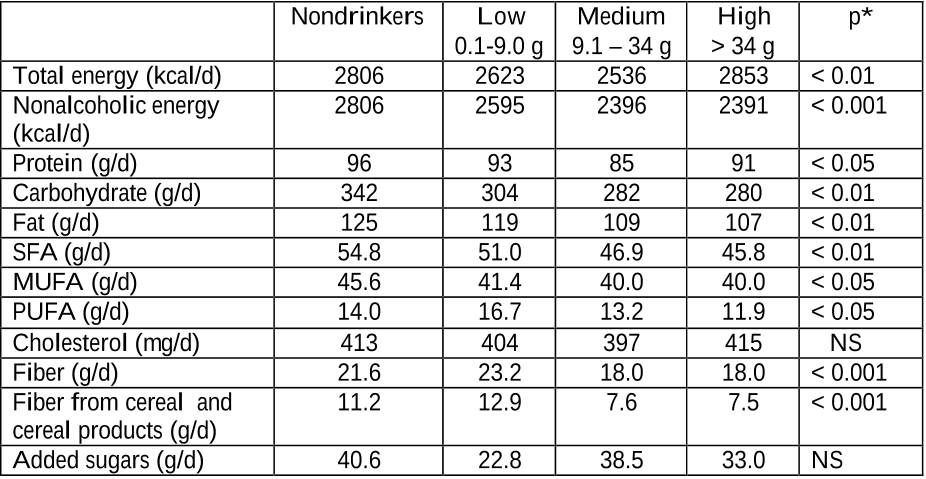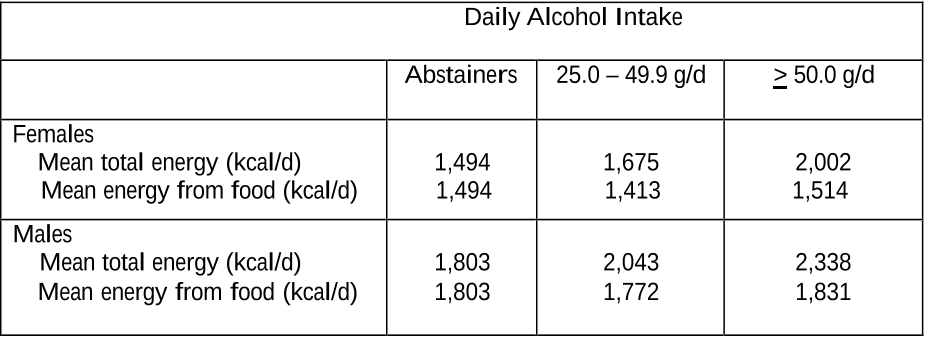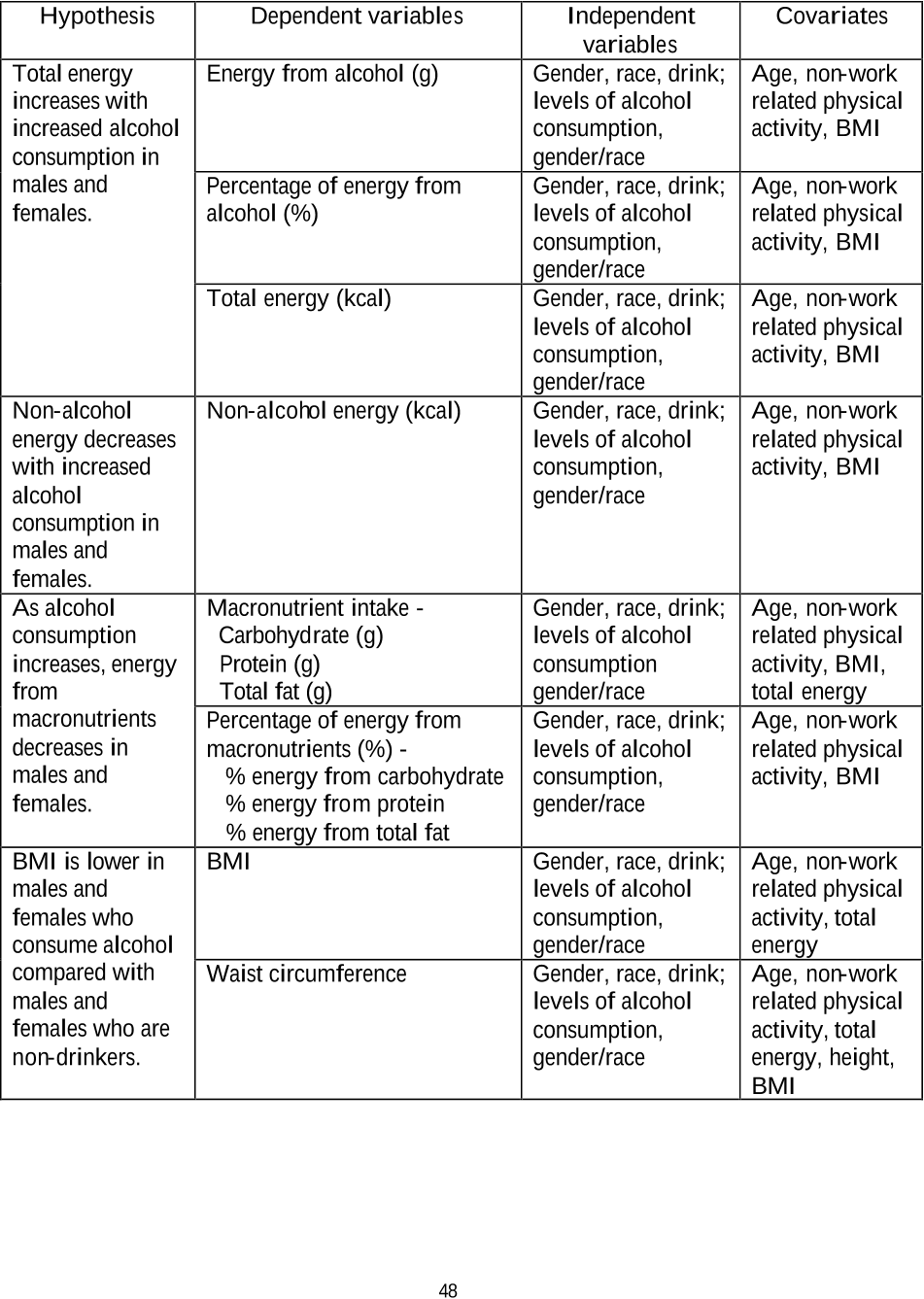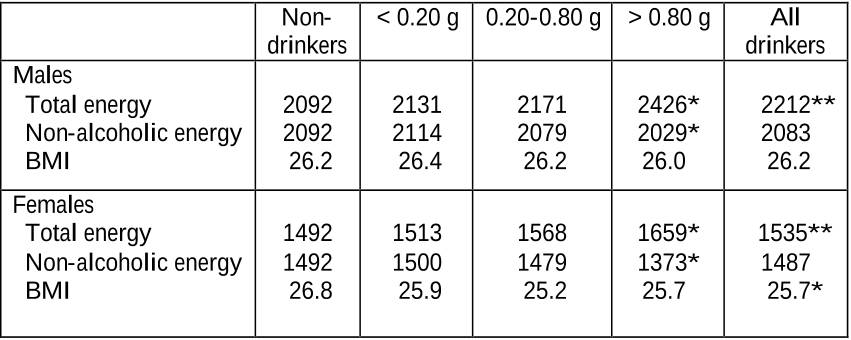The Relationship Among Alcohol Consumption, Dietary Intake, and Body Mass Index in Young Adults
About: This article is published in Journal of The American Dietetic Association.The article was published on 2005-08-01 and is currently open access. It has received 2 citations till now. The article focuses on the topics: Body mass index.
Summary (1 min read)
Jump to: [Introduction] – [Prevalence of Alcohol Consumption in Young Adults] – [Alcohol Metabolism] – [Overview] and [Body Mass Index]
Introduction
- She is an excellent mentor for whom my respect has grown tremendously over the past semesters.
- In 1995 to 1996, the Bogalusa Heart Study (BHS), an epidemiologic study of CVD risk factors from birth through young adulthood, surveyed young adults who were BHS participants in childhood to assess dietary intake and alcohol consumption.
- The YAQ is a semi-quantitative food frequency questionnaire in which foods are grouped into broad categories.
Prevalence of Alcohol Consumption in Young Adults
- The National Household Survey on Drug Abuse , a project of the Substance Abuse and Mental Health Services Administration of the federal government, was initiated in 1971 and is the primary source of information on the use of illicit drugs, alcohol, and tobacco (13).
- NHANES reports that the prevalence of overweight and obesity for adults was relatively constant from 1960 to 1980; however, by 1988-1994 NHANES III, overweight 12 and obesity increased significantly for white and black males and females aged 20 to 74 (45).
- They were shown to be valid and reproducible in both populations.
- Energy from alcohol was added to the diets of light drinkers but replaced non- alcohol energy, especially from carbohydrates, in moderate and heavy drinkers (15).
- A study of 179 middle-class males was designed to quantify long-term alcohol intake and to investigate the relation of level of alcohol consumption with dietary intake (71).
Alcohol Metabolism
- The paradoxical inverse relation sometimes seen between alcohol consumption and body weight remains unexplained by nutritionists.
- When alcohol energy was added to non-alcohol energy, subjects failed to gain weight (78, 81).
- Alcohol may increase meal size through a combination of direct and indirect effects (95).
- Frequency of drinking was consistently lower for females than for males.
- Possible effects of changes in marital status, employment status, and having children on alcohol consumption and the frequency of heavy drink ing was examined in 1,327 males and females aged 16 to 69 years (119).
Overview
- General data collection procedures used in the Bogalusa Heart Study (BHS) are described below; however, a specific data set was used for this thesis.
- The study design, participation, and protocols are described in detail elsewhere (39).
Body Mass Index
- The adjusted means (+ SE) for BMI (kg/m2) of drinkers by gender, race, and race/gender are shown in Table 11a.
- No other significant differences were seen among levels of alcohol consumption.
- Waist Circumference Table 12a shows the adjusted means (+ SE) for waist circumference (cm) of drinkers by gender, race, and race/gender.
Did you find this useful? Give us your feedback
Figures (13)

Table 2 Mean daily intake of energy (kcal/d) and selected dietary components (g/d, mg/d) according to level of alcohol consumption for 164 males (70) 
Table 7c Frequencies and percentages of non-drinkers and drinkers by race and gender 
Table 8b Adjusted means (+ SE) for alcohol intake (g/d) and the 
Table 1 Adjusted mean energy intake (kcal/d) by level of alcohol intake, in females and males (66) 
Table 10c shows the adjusted means (+ SE) for non alcohol energy intake (kcal/d) 
Table 5 Relation of health-related behaviors at three levels of alcohol intake (71) 
Table 6 Hypothesis, dependent variables, independent variables, and covariates used in the univariate ANOVA 
Table 11b Adjusted means (+ SE) for BMI (kg/m2) for non-drinkers and drinkers 
Table 14a Adjusted means (+ SE) for protein (g) and percentages (%) of total energy from protein for drinkers by gender, race, and race/gender 
Table 4 Mean total energy intake and energy sources at three levels of alcohol consumption (71) 
Table 3 Age-standardized daily energy intakes and BMIs for males and females by alcohol consumption (15) 
Table 15a Adjusted means (+ SE) for total fat (g) and percentages (%) of 
Figure 1. Past alcohol use by age: 2001 (Source: NHSDA).
Citations
More filters
01 Jan 1983
TL;DR: Intake of spirits and beer as well as smoking was measured by questionnaire in a random population sample from two counties of Eastern Finland in 1972 and during a 7-yr follow-up 209 of these men had developed an acute myocardial infarction and 223 men had died.
Abstract: Intake of spirits and beer as well as smoking was measured by questionnaire in a random population sample from two counties of Eastern Finland in 1972. At the same time serum cholesterol, triglycerides and blood pressure were measured in a field examination. The study material consists of 4063 men aged 30-59 years (participation rate 92%). During a 7-yr follow-up 209 of these men had developed an acute myocardial infarction (AMI) and 223 men had died. Reported spirits and beer intake had both a strong positive association with smoking and serum triglycerides, a weak positive association with diastolic blood pressure, but no relationship to serum total cholesterol. Use of spirits at least once a week was associated with a reduced risk of AMI. The relative risk (RR), adjusted for age and conventional coronary risk factors was 0.5 (95% confidence interval (CI), 0.3-0.9). Consumption of beer had no significant relationship to the risk of AMI. Consumption of at least five bottles of beer a week was related to a slightly excessive risk of death from any cause (adjusted RR = 1.5, 95% CI = 1.0-2.1). Spirits intake had no significant association with the risk of death.
84 citations
01 Jan 1987
TL;DR: For example, this article found that women who consumed alcohol 7-13 times per week had the greatest reduction in weight, while men had only a slight effect on weight in either survey.
Abstract: Alcohol contributes more than 10 per cent of the total caloric intake of adult drinkers in the United States. However, the effect of alcohol on body weight has not been adequately studied in the general population. The association between weight and frequency of alcohol consumption was examined in two national cross-sectional surveys: the Second National Health and Nutrition Examination Survey (HANESII; n = 10,929) and the Behavioral Risk Factor Surveys (BRFS; n = 18,388). Linear multiple regression was used to estimate the independent effect of alcohol on weight, adjusting for smoking, age, diet practices, physical activity, race, education, and height. Among men, alcohol had only a slight effect on weight in either survey. However, among women, alcohol was associated with a substantial reduction in weight, which was as large as the effect of smoking. Compared with nondrinkers, women who consumed alcohol 7-13 times per week had the greatest reduction in weight: -3.6 kg (95% confidence limits [CL] = -5.6,...
6 citations
References
More filters
TL;DR: The data suggest that alcohol intake does not increase the risk of obesity and that both men and women drinkers tended to gain less weight and have more stable weight over the 10-year follow-up period.
Abstract: Little is known about the role of alcohol in determining change in body weight. In this paper, the authors examine the relation between alcohol intake and body weight in 7,230 US adults aged 25-74 years who participated in the First National Health and Nutrition Examination Survey (1971-1975) and who were reweighed 10 years later (1982-1984). Both cross-sectional and prospective analyses were adjusted for age, race, height, education, health status, smoking status, diet status, physical activity, and total nonalcoholic caloric intake. At baseline, women who reported at least one drink per day weighed 2.3 kg less than nondrinkers (95% confidence interval (CI) -0.4 to -4.2). Little relation was observed between body weight and alcohol intake cross-sectionally among men. Prospectively, both men and women drinkers tended to gain less weight than did nondrinkers (p = 0.006 for trend in women, p = 0.11 for trend in men). Drinkers also had more stable weight over the 10-year follow-up period. Drinkers were less likely to have major weight gain or loss (gaining or losing > or = 10 kg) than were nondrinkers. Compared with nondrinkers, for those who consumed 1-6.9 drinks per week, women had an odds ratio (OR) = 0.7 (95% CI 0.5 to 0.9) for major weight gain and an OR = 0.7 (95% CI 0.5 to 1.1) for major weight loss, while men had an OR = 1.0 (95% CI 0.6 to 1.6) for major weight gain and an OR = 0.7 (95% CI 0.5 to 1.2) for major weight loss. For those who consumed > or = 2 drinks per day, women had an OR = 0.5 (95% CI 0.3 to 1.0) for major weight gain and an OR = 0.8 (95% CI 0.4 to 1.6) for major weight loss, while men had an OR = 0.9 (95% CI 0.5 to 1.6) for major weight gain and an OR = 1.0 (95% CI 0.6 to 1.7) for major weight loss. These data suggest that alcohol intake does not increase the risk of obesity.
133 citations
TL;DR: The Bogalusa Heart Study, a long‐term population study with a continued relationship with a community, addresses the problem of capacity building in minority health research by studying children for early clinical evidence of major adult heart diseases.
132 citations
TL;DR: It is indicated that regular consumption of small to moderate amounts of alcoholic beverages, regardless of the type, reduces the risk of myocardial infarction, and further suggest that there is benefit, in large part, from increases in HDL levels.
Abstract: We examined the relation of alcoholic beverage type and risk of myocardial infarction (MI) in a case-control study among 340 cases of MI and an equal number of age-, sex-, and community-matched controls. Alcohol consumption was estimated using a food frequency questionnaire, with alcohol drinkers defined as those consuming > or = 1/2 drink/day on average of any alcoholic beverage. Beer, wine, and liquor drinkers had at least half of their consumption from 1 beverage type. Fasting venous blood samples were obtained and analyzed for lipid profiles. Compared with nondrinkers, after adjustment for age and sex, reductions in risk of MI were similar for regular drinkers of any type of alcoholic beverage (relative risk [RR] 0.54; 95% confidence interval [CI] 0.37 to 0.79; p = 0.001), beer (RR 0.55; 95% CI 0.31 to 0.97; p <0.05), wine (RR 0.48; 95% CI 0.27 to 0.87; p <0.05), and liquor (RR 0.59; 95% CI 0.38 to 0.91; p <0.05) drinkers. Comparable benefits remained apparent even after multivariate adjustment for a wide range of nonlipid coronary risk factors. High-density lipoprotein (HDL) levels were significantly higher in all 4 beverage categories when compared with levels in nondrinkers, and as expected, adjustment for total HDL, a major direct effect of alcohol, substantially attenuated the protective effect in all 4 beverage categories. Relative risks were 0.94 for any beverage, 1.09 for beer, 0.97 for wine, and 0.83 for liquor after further adjustment. This strongly suggests that the protective effect of each beverage type is, in large part, mediated by increased HDL. These data indicate that regular consumption of small to moderate amounts of alcoholic beverages, regardless of the type, reduces the risk of MI, and further suggest that there is benefit, in large part, from increases in HDL levels.
131 citations
TL;DR: There was a trend toward increased energy intake as alcohol consumption increased; however when the population was divided into tertiles based on alcohol consumption, the energy intakes were not significantly different between the tertile groupings.
129 citations
TL;DR: For example, this paper found that women who consumed alcohol 7-13 times per week had the greatest reduction in weight, while men had only a slight effect on weight in either survey.
Abstract: Alcohol contributes more than 10 per cent of the total caloric intake of adult drinkers in the United States. However, the effect of alcohol on body weight has not been adequately studied in the general population. The association between weight and frequency of alcohol consumption was examined in two national cross-sectional surveys: the Second National Health and Nutrition Examination Survey (HANESII; n = 10,929) and the Behavioral Risk Factor Surveys (BRFS; n = 18,388). Linear multiple regression was used to estimate the independent effect of alcohol on weight, adjusting for smoking, age, diet practices, physical activity, race, education, and height. Among men, alcohol had only a slight effect on weight in either survey. However, among women, alcohol was associated with a substantial reduction in weight, which was as large as the effect of smoking. Compared with nondrinkers, women who consumed alcohol 7-13 times per week had the greatest reduction in weight: -3.6 kg (95% confidence limits [CL] = -5.6,...
127 citations